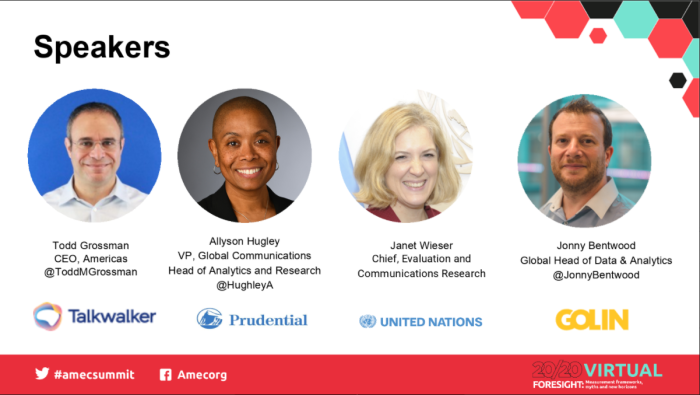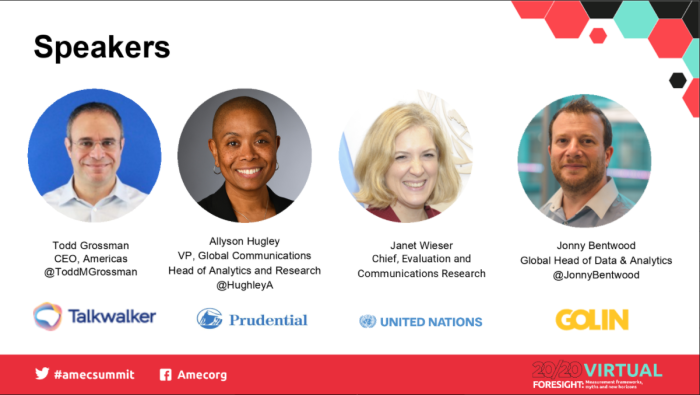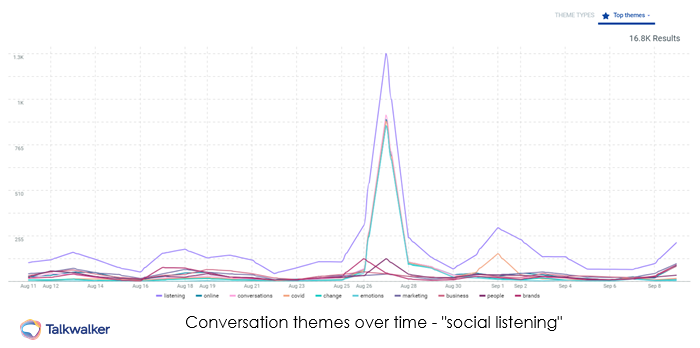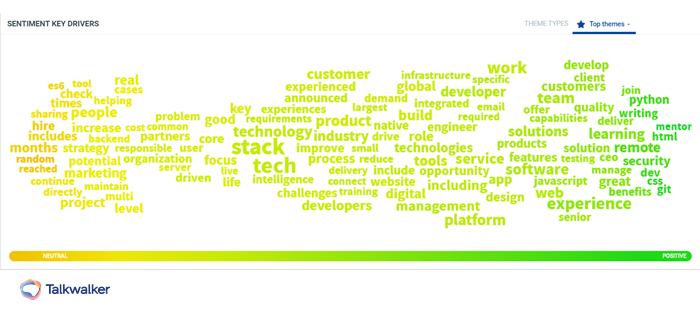DOWNLOAD: The 2020 Agency Industry Report
It often feels that our decades-long Information Age has devolved into the Misinformation Age. With more access to news and data than ever before, it’s become difficult for media consumers and producers alike to find the needle of truth in the internet haystack.
Brands and organizations are increasingly using social listening tools and artificial intelligence to help them understand complex conversations happening across the web so that they can respond in the most informed way. On August 27, 2020, Talkwalker CEO Todd Grossman discussed this phenomenon and its impact on the communications industry with experts in the field during the AMEC webcast, “The Future of PR Measurement Technology” part of the 2020 Global Summit on Measurement.

The esteemed panelists included Allyson Hugley (VP, Global Communications, Head of Analytics and Research at Prudential Financial), Janet Wieser (Chief Evaluation and Communications Research Unit for the United Nations) and Jonny Bentwood (Global Head of Data & Analytics at Golin), who shared how they have honed strategies in 2020 to allow them to stay connected while cutting through the noise. In particular, they discussed:
- The role of human intelligence alongside AI and machine learning.
- Talent mapping and the skill sets needed for the future of PR.
- How to select tools that meet your needs and grow with your organization.
- The value of a cross-functional approach to tools and data insights.
The panelists had four major takeaways for PR professionals who are exploring how social listening and AI should fit into their tech stack. Despite all of the third-party tools available, there’s still a very personal element to effective PR measurement:
1. Combatting the “infodemic” with human intellect - AI helps, but you still need people power
Many PR professionals are using technology to solve new challenges brought on by this year. Both their clients and employees have been bombarded with a near-constant news stream - in Janet’s words, we’re “experiencing the first pandemic of the social age” and in turn, suffering through an “infodemic” that makes it difficult to identify credible, trustworthy sources. It’s had an impact on how each panelist has approached their tech solutions.
The United Nations uses social listening and measurement tools to monitor ongoing global issues, but still relies on human beings to make decisions around the data. Janet spoke to how AI can’t always solve for the linguistic differences, cultural viewpoints, and regional context that must be taken into account before making policy. Metrics should help inform your work, but you need humans with empathy and experience to make impactful, data-driven decisions.
View this post on InstagramA post shared by United Nations (@unitednations) on
Spreading awareness around the detrimental impact of misinformation is one of the UN’s missions on social media in 2020.
At Prudential, pre-2020 comms measurement had an external focus, and the primary purpose for tech solutions was customer relationship management. Now, Allyson shared that there is a need for internal community building that has shifted the company’s IT priorities. Tools have evolved to meet emerging employee needs, and Prudential’s tech stack reflects the necessity to stay connected with internal and external stakeholders alike.
With more online conversation to monitor than ever, Golin has combined machine learning technology and AI this year to get actionable insights on what real people are saying online and prepare for what’s coming next. Jonny shared that while “70% of conversation was about COVID-19” earlier in 2020, online discussion has diversified since. Comms professionals can track the long -term impact of the pandemic and worldwide social movements on consumers’ buying decisions with social intelligence tools. Machine learning has allowed Golin to examine conversations of the past for clarity, and AI helps the firm predict future consumer trends based on what people are talking about now.
Proud to be a finalist for the @PRWeekUS #PurposeAwards for our work with #client @PepsiCo on the COVID-19 Restaurant Industry Relief campaign. Fingers crossed for a win on October 14th! #goallin https://t.co/ZLCrNX4Gxy
— Golin (@GOLINglobal) August 12, 2020
By using tech to understand consumer trends, Golin helps its clients create agile brand initiatives that drive positive PR and long-term customer retention.
2. Embrace diversity in hiring practices - varied backgrounds make for a better team
All panelists agreed that having mastery of the ever-evolving tools of PR comms monitoring is an important factor in hiring, but having diverse backgrounds represented make those skills even more valuable to organizations.
Allyson shared that Prudential looks for team members who are critical thinkers and tuned into the context of cultural moments as much as the conversational data around them. PR professionals should have a grasp of what’s “happening in the margins” and shape brand response with both hard numbers and emotional sensitivity.
This year, the commemoration of Juneteenth has taken on increased significance. @Prudential recognizes that meaningful change will take all of us, working together. Read more from @LataReddy and @Salene
— Prudential (@Prudential) June 19, 2020
Prudential shows how brands need to do more than simply respond to social activism, but take steps to elevate voices within the organization to enact real change.
The Golin team looks to hire employees who can tell a successful narrative with the data points, in addition to pulling reporting. Jonny said that you “can’t assume that your tech will take the place of team members”. Social listening and AI only goes so far before you need people to interpret data and strategize accordingly. Information needs to be presented well, and PR hires need to be able to explain why metrics matter and the impact they can make.
Similarly, Janet discussed how senior leaders should use social listening and conversational intelligence tools to establish context for decision making, and they also need to be able to explain that context to their audience. New tools are great to have - “use AI, Boolean, and machine learning to your advantage” - but human intelligence still needs to make sense of everything. That is what drives data’s ultimate value to your organization.
Recent conversations around “social listening” shows trending discussions around how martech tools can influence “change”, “emotions”, “brands” and “people”.
3. Find a partner rather than a vendor - avoid “overselling” to identify the right tech solution
So, how do you build the most effective tech stack? Jonny emphasized finding a tech partner, and not just a tech platform. Work with companies that want to collaborate with you and go beyond basic trend research to build solutions that will help you see what happens next. He spoke about the fact that some teams may think that developing proprietary tools can save money, but companies should take human resources into account before making that decision. Get an “ally” along with a platform, one who will make their tech work effectively with yours.
Allyson advised being wary of overselling, as “aggressive salespeople may try to push products onto you that you don’t need”. A true tech partner will find you the solution that fits you best, help your organization with the transition process, and even look for ways to support more internal collaborations to prove further value to your entire company. This kind of partnership benefits everyone - it helps them retain your business, and helps you retain your budget for the tool.
In looking at conversations related to “tech stack”, positive sentiment originates with customer experience and solution-oriented services.
At the UN, Janet shared that overselling and budget limitations can be a pitfall in their IT structure (especially as a non-profit organization that needs cost-effective solutions). Avoid this by establishing data priorities that are aligned across the organization as you go into your sales process, and find tools that can be cross-functional. This can help spread the cost of new solutions around to make it more affordable if you’re tight on budget.
Get ahead of the trends: download the 2020 Agency Report
4. Make tech work for you - meet more than one team’s need to achieve the best results
There are many tech solutions out there that can help brands monitor online conversation and forecast trends. The key to using them successfully is finding the tools that meet the needs of your company most effectively.
Real-time data plays a huge role in trend response and forecasting, and Jonny shared how Golin uses a mix of free and paid tools to help them diversify their data. This helps the PR agency get specialized results depending on each platform’s strength, to then craft the appropriate response for the moment. Explore your options to find what works for you, and test and learn to see which solution fits your team’s needs.
Allyson shared that they have a similar tech stack approach at Prudential and you should “look for tech solutions that grow with you”. It’s essential now that tools be customizable to the organization’s changing needs. Technology needs to be relevant and enable teams to make better decisions on every level. Janet’s work with tools at the UN aligns with this thinking - it’s all about what makes the most internal impact. What solution delivers the end results that you need across your organization? When you find it, it's worth the investment.
Interested in more PR insights from industry experts? Join AMEC this November for Measurement Month, featuring insightful sessions and events from the organization’s members around the future of PR communications worldwide.





